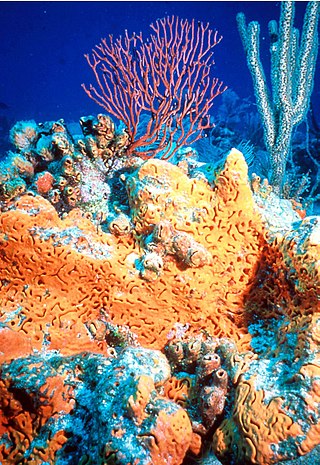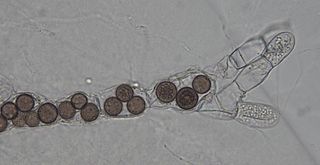
The opisthokonts are a broad group of eukaryotes, including both the animal and fungus kingdoms. The opisthokonts, previously called the "Fungi/Metazoa group", are generally recognized as a clade. Opisthokonts together with Apusomonadida and Breviata comprise the larger clade Obazoa.

Microsporidia are a group of spore-forming unicellular parasites. These spores contain an extrusion apparatus that has a coiled polar tube ending in an anchoring disc at the apical part of the spore. They were once considered protozoans or protists, but are now known to be fungi, or a sister group to fungi. These fungal microbes are obligate eukaryotic parasites that use a unique mechanism to infect host cells. They have recently been discovered in a 2017 Cornell study to infect Coleoptera on a large scale. So far, about 1500 of the probably more than one million species are named. Microsporidia are restricted to animal hosts, and all major groups of animals host microsporidia. Most infect insects, but they are also responsible for common diseases of crustaceans and fish. The named species of microsporidia usually infect one host species or a group of closely related taxa. Approximately 10 percent of the species are parasites of vertebrates —several species, most of which are opportunistic, can infect humans, in whom they can cause microsporidiosis.

Cristidiscoidea or Nucleariae is a proposed basal holomycota clade in which Fonticula and Nucleariida emerged, as sister of the fungi. Since it is close to the divergence between the main lineages of fungi and animals, the study of Cristidiscoidea can provide crucial information on the divergent lifestyles of these groups and the evolution of opisthokonts and slime mold multicellularity. The holomycota tree is following Tedersoo et al.
In biology, a phylum is a level of classification or taxonomic rank below kingdom and above class. Traditionally, in botany the term division has been used instead of phylum, although the International Code of Nomenclature for algae, fungi, and plants accepts the terms as equivalent. Depending on definitions, the animal kingdom Animalia contains about 31 phyla, the plant kingdom Plantae contains about 14 phyla, and the fungus kingdom Fungi contains about 8 phyla. Current research in phylogenetics is uncovering the relationships among phyla within larger clades like Ecdysozoa and Embryophyta.

Holozoa is a clade of organisms that includes animals and their closest single-celled relatives, but excludes fungi and all other organisms. Together they amount to more than 1.5 million species of purely heterotrophic organisms, including around 300 unicellular species. It consists of various subgroups, namely Metazoa and the protists Choanoflagellata, Filasterea, Pluriformea and Ichthyosporea. Along with fungi and some other groups, Holozoa is part of the Opisthokonta, a supergroup of eukaryotes. Choanofila was previously used as the name for a group similar in composition to Holozoa, but its usage is discouraged now because it excludes animals and is therefore paraphyletic.

The apusomonads are a group of protozoan zooflagellates that glide on surfaces, and mostly consume prokaryotes. They are of particular evolutionary interest because they appear to be the sister group to the Opisthokonts, the clade that includes both animals and fungi. Together with the Breviatea, these form the Obazoa clade.

The Filozoa are a monophyletic grouping within the Opisthokonta. They include animals and their nearest unicellular relatives.

Rozella is a fungal genus of obligate endoparasites of a variety of hosts, including Oomycota, Chytridiomycota, and Blastocladiomycota. Rozella was circumscribed by French mycologist Marie Maxime Cornu in 1872. Considered one of the earliest diverging lineages of fungi, the widespread genus contains 27 species, with the most well studied being Rozella allomycis. Rozella is a member of a large clade of fungi referred to as the Cryptomycota/Rozellomycota. While some can be maintained in dual culture with the host, most have not been cultured, but they have been detected, using molecular techniques, in soil samples, and in freshwater and marine ecosystems. Zoospores have been observed, along with cysts, and the cells of some species are attached to diatoms.

Holomycota or Nucletmycea are a basal Opisthokont clade as sister of the Holozoa. It consists of the Cristidiscoidea and the kingdom Fungi. The position of nucleariids, unicellular free-living phagotrophic amoebae, as the earliest lineage of Holomycota suggests that animals and fungi independently acquired complex multicellularity from a common unicellular ancestor and that the osmotrophic lifestyle was originated later in the divergence of this eukaryotic lineage. Opisthosporidians is a recently proposed taxonomic group that includes aphelids, Microsporidia and Cryptomycota, three groups of endoparasites.

Cryptomycota , Rozellida, or Rozellomycota are a clade of micro-organisms that are either fungi or a sister group to fungi. They differ from classical fungi in that they lack chitinous cell walls at any trophic stage in their lifecycle, as reported by Jones and colleagues in 2011. Despite their unconventional feeding habits, chitin has been observed in the inner layer of resting spores, and in immature resting spores for some species of Rozella, as indicated with calcofluor-white stain as well as the presence of a fungal-specific chitin synthase gene.

Choanozoa is a clade of opisthokont eukaryotes consisting of the choanoflagellates (Choanoflagellatea) and the animals. The sister-group relationship between the choanoflagellates and animals has important implications for the origin of the animals. The clade was identified in 2015 by Graham Budd and Sören Jensen, who used the name Apoikozoa. The 2018 revision of the classification first proposed by the International Society of Protistologists in 2012 recommends the use of the name Choanozoa.

Aphelida is a phylum of Fungi that appears to be the sister to true fungi.

Cryptista is a clade of alga-like eukaryotes. It is most likely related to Archaeplastida which includes plants and many algae, within the larger group Diaphoretickes.
Cladochytriales is an order of chytrid fungi. It is the only order in the monotypic class Cladochytriomycetes. The order was described in 2009 to accommodate a monophyletic clade containing many genera of chytrid fungi often observed growing over decaying plant tissue and other cellulosic substrates from aquatic habitats and humid soils.
Aphelidium species are endoparasites of freshwater green algae. Aphelidium belongs to the phylum Aphelida, and is part of the Opisthosporidia, a sister clade to Fungi. The cells of Aphelidium are much smaller than the cells of its green algae host, which is protected by a robust cell wall. Aphelidium have evolved a remarkable life cycle to defeat host's defenses.

Amastigomycota or Eufungi is a clade of fungi. It includes all fungi without flagella or centrioles, and with unstacked Golgi apparatus cisternae. Members of this clade are Dikarya and the traditional paraphyletic assemblage "Zygomycota", now divided into several monophyletic phyla.
Calcarisporiellaceae is a family of fungi within the subkingdom Mucoromycota. It is the only family in the order Calcarisporiellales, class Calcarisporiellomycetes, subphylum Calcarisporiellomycotina and phylum Calcarisporiellomycota. It contains two known genera, Calcarisporiella and Echinochlamydosporium. The two genera each have one species.
Savoryellomycetidae is a subclass of sac fungi within the class of Sordariomycetes. It contains 4 known orders of Conioscyphales, Fuscosporellales, Pleurotheciales and Savoryellales.
Conioscyphales is an order of freshwater and terrestrial fungi within the division Ascomycota. It is in the subclass Savoryellomycetidae and the class Sordariomycetes and the subdivision of Pezizomycotina.

Aphelidium tribonemae is a species within the Aphelid group. Their classification in the kingdom Fungi is a subject of controversy. Some argue for the classification of aphelids as ‘fungal animals', and for a period of time in the 1950s, aphids were classified as protists due to their amoeboid stage. Recently, molecular phylogenetics placed the aphelids within Opisthosporidia, a super phylum within Opisthokonta. Aphelids have posterior uniflagellate zoospores which place them as Opisthokonts. They are an early diverging lineage in Kingdom Fungi. While the aphelid group only contains three genera, it spans many both freshwater and marine ecosystems.














